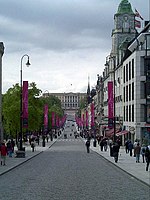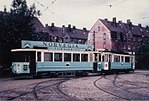Stortinget station

Stortinget is an underground rapid transit station on the Common Line of the Oslo Metro, Norway. It is located in the heart of the city center, next to the Parliament of Norway Building (Stortinget). The station is served by all of the five lines of the metro. At the street level, the station serves tram routes 11, 12, 13, 17, 18 and 19. Lines 11, 12 and 13 serves Øvre Slottsgate on the Vika Line while Lines 17, 18 and 19 stops at Tinghuset in the Ullevål Hageby Line. Also close to the station, there is a stop named Prof. Aschehougs gate that stops line FB5 to Oslo Airport, Gardermoen. Stortinget is 'kilometer marker zero' for the metro network and is owned by Sporveien T-banen. There has been a tram stop at Tinghuset since the opening of the Oslo Tramway, in 1875. The rapid transit station opened as Sentrum in 1977, and was connected to the eastern network of the metro. It was forced to close in 1983 due to leaks. It took the new name following the 1987 re-opening; this time it was also connected to the western network. The station has four platforms; originally two were used for the eastern trains and two for the western ones. Since 1993, trains have passed through the station.
Excerpt from the Wikipedia article Stortinget station (License: CC BY-SA 3.0, Authors, Images).Stortinget station
Egertorget, Oslo Sentrum
Geographical coordinates (GPS) Address Website Nearby Places Show on map
Geographical coordinates (GPS)
| Latitude | Longitude |
|---|---|
| N 59.912777777778 ° | E 10.741666666667 ° |
Address
Samson konditori
Egertorget
0157 Oslo, Sentrum
Norway
Open on Google Maps








